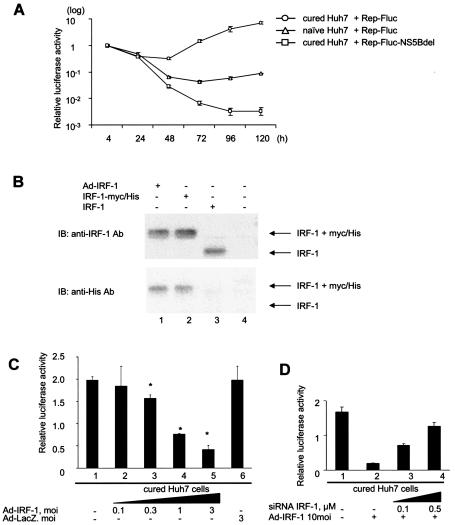FIG. 6.
Cured Huh7 cells lost their permissiveness for the HCV replicon with overexpression of IRF-1. Transient replication assays were performed on cured Huh7 cells to determine whether the downregulation of IRF-1 enables replication of the HCV replicon. (A) The high permissiveness of cured Huh7 cells is shown. The HCV replicon expressing the firefly luciferase, Rep-Fluc, was transfected into cured Huh7 cells and naive Huh7 cells by electroporation. As a negative control, Rep-Fluc-NS5Bdel also was transfected into the cells. The luciferase activities of the cell lysates were measured. To correct for the efficiency of induction, each value is shown as a ratio relative to the relevant relative light units at 4 h. (B) The IRF-1 protein produced by IRF-1-expressing recombinant adenovirus, Ad-IRF-1, was examined. Cured Huh7 cells were infected at an MOI of 3 with Ad-IRF-1 (lane 1). As a control, pcDNA3-IRF-1 (lane 2) and pcDNA4/to/IRF-1-Myc/His (lane 3) were transfected on cured Huh7 cells by using FuGENE-6. At 48 h after transfection, nuclear extracts were isolated and Western blot analysis was performed with anti-IRF-1 antibody and anti-His antibody, as previously described. (C) To determine the effect of supplementation of IRF-1 on the cured Huh7 cells, various titers of Ad-IRF-1 were used to infect the cured Huh7 cells 3 h before electroporation of Rep-Fluc. The relative values of 72 h over 4 h were calculated. The data are means ± the SD. ★, P < 0.01 (relative to null transfection [lane 1]). (D) To determine whether overexpression of IRF-1 affected the permissiveness of the cured Huh7 cells, a transient assay was performed with an siRNA directed to IRF-1 mRNA. At 3 h before electroporation, the cured Huh7 cells were infected with Ad-IRF-1 at MOI of 10. Rep-Fluc and the siRNA oligonucleotide directed to IRF-1 were transfected by electroporation. The relative values of 72 h over 4 h were calculated.

